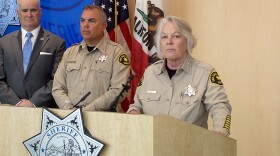Most of the attention on San Onofre Nuclear Generating Station’s failure is focused on a deal that requires customers to pay billions of dollars for its closure.
But Southern California Edison and San Diego Gas & Electric are quick to claim ratepayers could also receive a multi-billion dollar refund.
The bonanza depends on whether the utilities prevail in arbitration against the maker of the flawed steam generators that sprung a radioactive leak just one year after they were installed, forcing San Onofre’s permanent closure.
Edison wants $7.6 billion in damages from Mitsubishi Heavy Industries. Edison and SDG&E must share half of what they might receive with customers.
“My reaction is rooty toot toot,” said Charles Langley, a ratepayer advocate. “It’s smoke and mirrors. They’ll never see that money.”
Although Edison accuses Mitsubishi of misconduct, documents dating back several years reveal a more complicated relationship. Ties between the two were punctuated by praise, doubt and an understanding that their joint venture was unprecedented. What’s more, records show Edison was aware of the project’s risks.
Edison chose Mitsubishi to build the steam generators based on cost and the manufacturer’s experience in building a smaller version for a Nebraska nuclear plant.
“You have a bunch of executives at SoCal Edison who in 2005 sat down and decided to put an experimental nuclear generator into operation at San Onofre,” Langley said.
In a 2004 letter to Mitsubishi, then-Edison Vice President Dwight Nunn called the manufacturer the “best match for our needs” and described the steam generators as one of the largest ever built.
Given the size, he said the company would team up with Mitsubishi’s engineering group to help with the design, acknowledging also the utility’s own lack of expertise.
Premature tube wear inside the steam generators caused the radioactive leak in 2012.
Two months into the project, Nunn noted problems.
“I am concerned that there is the potential that design flaws could be inadvertently introduced into the steam generator design that will lead to unacceptable consequences,” wrote Nunn in the 2004 letter to Mitsubishi.
And then he cited tube wear.
“This would be a disastrous outcome for both of us and a result each of our companies desire to avoid,” Nunn wrote.
The conversation didn’t end there. Edison engineers also spoke of the tube wear issue with Mitsubishi staff at a meeting in Japan four months later. Documents also reveal the engineers described Mitsubishi’s prior experience in building smaller steam generators as “invalid.”
“These are engineers, engineers that are planning something,” said former San Diego City Attorney Mike Aguirre, who wants a probe into whether Edison was at fault for deploying the defective steam generators. “They test everything before they take another step. And they say ‘OK, this isn’t going to work.’”
Still, Edison claims Mitsubishi provided false assurances throughout the steam generator design process.
The Root Cause Analysis Report For Tube Wear, however, shows Mitsubishi had potential fixes.
But the design team — which consisted of both Mitsubishi and Edison engineers — didn’t make the changes because of Edison’s desire to avoid a federal license amendment process, according to the report.
Aguirre contends Edison took a gamble and installed the new equipment without the needed corrections, believing state regulators wouldn’t hold the company accountable if its bet failed.
“Edison’s attitude was ‘look the worst that can happen is the plant will shut down, but we’ll still get paid...we just might not get as big a return on our money as we otherwise would,’” Aguirre said. “So Edison was flying high based on the idea that if there was a problem, it would be pushed off to the ratepayers. The PUC would bail out Edison and that’s exactly what happened.”
The California Public Utilities Commission never fully investigated Edison’s role in the steam generator debacle. Meanwhile, Edison’s own former President Ron Litzinger acknowledged under oath last year the company exercised oversight of the steam generator design.
Instead, the PUC approved a settlement agreement that requires customers to pay $3.3 billion so Edison and SDG&E can still receive a return on their San Onofre investment, even though the plant is not producing electricity. The deal has prompted outrage from consumers and lawmakers and is the subject of a criminal investigation.
Edison’s case against Mitsubishi is in arbitration. The company declined comment citing arbitration confidentiality. But in the past, the utility has said it never rejected design changes and would never install steam generators that would affect public safety.
In a press release, Mitsubishi argues that Edison’s allegations are “factually incorrect, legally unsound and inappropriate.”
Dan Benjamin, a San Diego lawyer, said most companies prefer arbitration because the process saves money and resolves disputes faster than court proceedings.
“Parties also prefer arbitration because it is private,” Benjamin said. “Court proceedings are held in public. Sometimes facts come out in litigation that don’t make a company look good.”
Mitsubishi’s contract with Edison limits its liability to $138 million.
Aguirre said Edison’s demand for $7.6 billion in damages from Mitsubishi with the idea that the public will get half is a ploy intended to dupe customers.
“It’s a phantom,” he said. “It’s another mirage. It’s another sleight of hand by Edison to create the impression that the public should support the settlement agreement because there’s some gold at the end of the rainbow, and it just doesn’t add up.”






